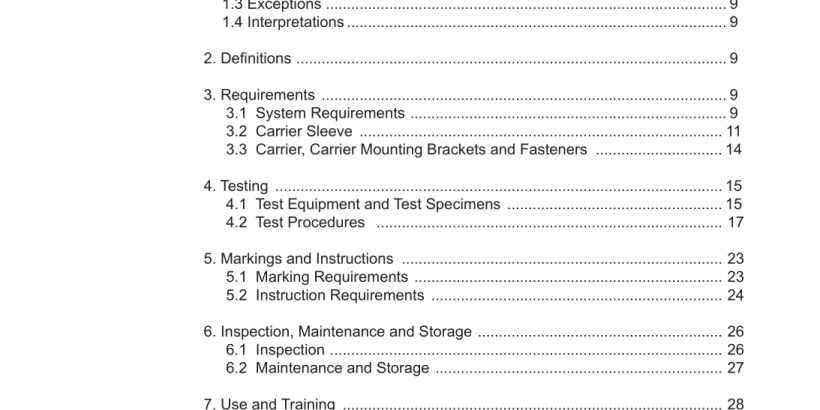ANSI ASSE Z359.16-2016 pdf download.Safety Requirements for Climbing Ladder Fall Arrest Systems
1.2.1 This standard applies to manufacturers, dis- tributors, purchasers and authorized persons that use climbing ladder fall arrest systems in occupa- tions requiring personal protection against falls from heights. It applies only to installations that are vertical (90 +/- 1 degrees) when viewed from the front elevation and within 15 degrees of verti- cal when viewed from the side elevation and that do not slope towards the climber. See Figure 2 for installation confgurations.
1.2.2 Before any equipment shall bear the marking “Z359.16” or be represented in any way as being in compliance with this standard, all applicable re- quirements of this standard shall be met through qualifcation and verifcation testing according to ANSI/ASSE Z359.7, Qualifcation and Verifcation Testing of Fall Protection Products.
1.2.3 Unless otherwise specifed, the values stated in this standard are expressed as nominal values. Except for temperature limits, values which are not stated as maxima or minima shall be subject to a tolerance of +/- 5%. Unless otherwise specified, the ambient temperature for testing shall be between 35°F (1.7°C) and 100°F (37.8°C) and the tempera- ture limits shall be subject to an accuracy of +/- 2°F (+/- 1°C).
1.2.5 This standard incorporates by dated or un- dated reference, provisions from other publications. These normative references are cited at the appro- priate places in the text and the publications are listed in Section 8. For dated references, subse- quent amendments to or revisions of any of these publications apply to this standard only when incor- porated in it by amendment or revision. For undat- ed references, the latest edition of the publication referred to applies.
1.2.6 All equipment within the scope of this standard that is marked or represented in any way as being in compliance with an ANSI/ASSE Z359 standard shall meet the requirements of this standard within 180 days of this standard’s publication date.
1.3 Exceptions. The requirements of this standard do not address material handling or sports related activities.
1.4 Interpretations. Requests for interpretations of this standard shall be in writing and addressed to the Secretariat of this standard.
3.1.2.2 The applied loads transferred to the climbing ladder mounting locations as a result of a fall shall be specified by the manufacturer (Section 5.2). For the purposes of determining the applied loads, the manufacturer shall assume that a load of at least 2,700 pounds (12kN) is transferred to the carrier via the carrier sleeve. For systems allowing more than two users, an additional 310 pounds (141kg) of applied load shall be included for each additional user. This additional load may be distributed to lo- cations along the carrier that reflect climber spacing as determined by the manufacturer.
3.1.3.1 For the dynamic performance test, a series of tests may be needed to address each CLFAS configuration. Each carrier size, construction or material allowed by the manufacturer for use with the carrier sleeve shall be tested. Systems with and without climbing extensions shall be tested as ap- plicable. Each different carrier mounting bracket design shall be tested in combination with one car- rier type.
3.1.3.2 When tested in accordance with 4.2.1, the average arrest force as determined by 4.2.1.2 shall not exceed 1,350 pounds (6kN) and the maximum arrest force shall not exceed 1,800 pounds (8kN). The total vertical displacement of the test weight including any extension of energy absorbing ele- ments “H” shall not exceed 39 inches (1m).
3.1.4.1 For the static strength test requirements that follow, a series of tests may be needed to address each CLFAS configuration. Each carrier size, con- struction or material allowed by the manufacturer for use with the carrier sleeve shall be tested. Sys- tems with and without climbing extensions shall be tested as applicable. Each different carrier mount- ing bracket design shall be tested in combination with one carrier type.
3.1.4.2 When tested in accordance with 4.2.2.3, any energy absorbing element as part of the con- nection linkage, carrier or carrier mounting brackets shall not show permanent extension of the energy absorber greater than 0.8 inch (20mm) following re- lease of a pre-load of 450 pounds (2kN) for a period of 1 minute.ANSI ASSE Z359.16-2016 pdf download
